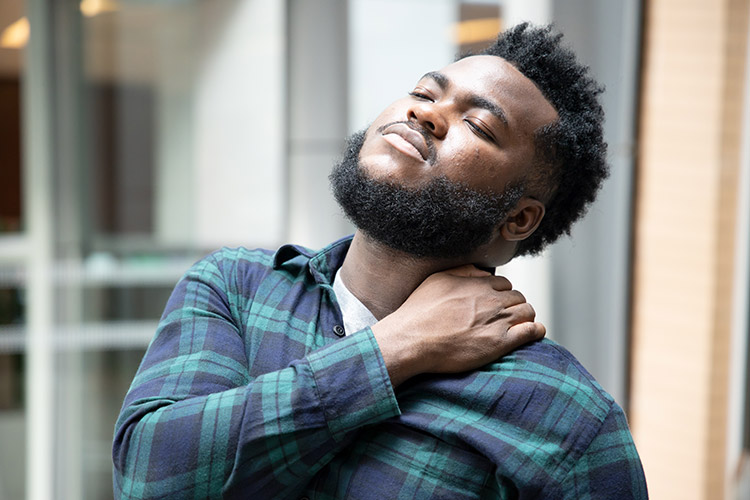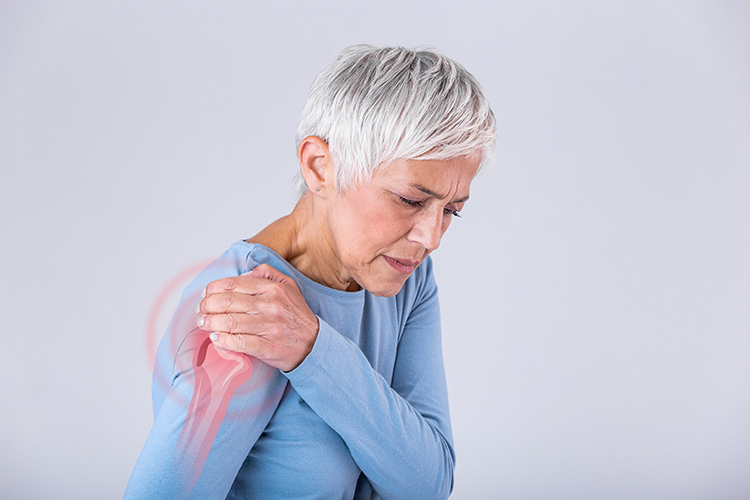Nerve pain in the neck and shoulder can be uncomfortable, and even unsettling. The good news is that often neck and shoulder nerve pain can be treated without surgery.
Let’s take a closer look at nerve pain in the shoulder and neck. We’ll discuss some of the common symptoms, and examine some of the most likely causes.
Symptoms of nerve pain in the neck and shoulders
Remember, only your doctor can accurately diagnose the cause of nerve pain, so it’s a very good idea to seek their advice if you are experiencing any of the symptoms we discuss below.
The symptoms of nerve pain in the neck and shoulder can vary based on a variety of factors. Some common symptoms include:
- Tingling or numbness (pins and needles) in the affected area
- Burning or shooting pain that may radiate down the arm
- Muscle weakness or atrophy
- Limited mobility and stiffness in the neck and shoulder
- Headaches
- Difficulty sleeping due to pain or discomfort
- Increased sensitivity to touch or pressure in the affected area.
Some people may experience isolated nerve pain in just one area, and others might feel neck and shoulder pain radiating down the arm.
Causes of shoulder and neck nerve pain
There are a number of conditions that might cause nerve pain in the neck and shoulder, sometimes radiating into the arm as well. Those conditions include

Radiculopathy
Radiculopathy is a condition where a nerve root in the spinal cord becomes compressed, inflamed, or damaged, leading to pain, numbness, or weakness in the area of the body that the nerve serves.
Myelopathy
Myelopathy is a condition that occurs when there is damage or dysfunction in the spinal cord that affects its ability to transmit signals between the brain and the rest of the body. This can result in a range of symptoms, including
- pain
- weakness
- numbness
- impaired coordination or balance
Cervical stenosis
Cervical spinal stenosis occurs when the nerves in the neck are affected. Symptoms include:
- Neck pain
- Weakness in the foot, leg, hand or arm
- Numbness or tingling in the hand or arm
- Problems with balance or walking
- In severe cases, problems with bowel or bladder function
Cervical Bone spurs
Cervical bone spurs, also known as cervical osteophytes, are bony growths that develop on the edges of the vertebrae in the neck region of the spine. They are a common age-related condition and can occur as a result of wear and tear on the spine over time. Cervical bone spurs can cause symptoms such as neck pain, stiffness, and reduced mobility.
Cervical disc herniation
Cervical disc herniation, also known as a herniated or slipped disc, occurs when the soft inner material of a cervical disc in the neck pushes through the tougher outer layer and into the spinal canal. This can put pressure on the nerves in the area, causing similar symptoms to what we’ve described above.
Cervical disc degeneration disease
Cervical disc degenerative disease is a condition that occurs when the cervical discs, which are the cushions between the vertebrae in the neck, begin to break down and deteriorate. This can happen due to various factors such as age, wear and tear, genetics, and injury.
Cervical Spondylosis
Cervical spondylosis is a condition that occurs when there is wear and tear on the discs and vertebrae in the neck region of the spine, leading to degeneration and various symptoms. This can include the development of bone spurs, bulging or herniated discs, and a loss of disc height. As a result, the spinal cord and nerves in the neck can become compressed, leading to symptoms such as neck pain, stiffness, and reduced mobility.
Cervical Kyphosis
Kyphosis, as we discuss on our website, “is a deformity of the spine where the curve of the upper back is excessively pronounced, creating a hump or “hunchback.”’ Cervical kyphosis can lead to symptoms such as neck pain, stiffness, and reduced mobility, as well as compression of the spinal cord or nerves in severe cases.
What can I do about nerve pain in the neck and shoulder?
The most important thing is to talk to your doctor (like Dr. Baig at Desert Spine and Scoliosis Center, for example) if you suspect any of the conditions we described above.
Once there, your doctor will perform a physical examination and review your medical history. They may order imaging tests such as an X-ray, MRI, and CT scan if they think that there is a condition they need to confirm. They may order other tests such as electromyography and nerve conduction studies, as well.
Finally, your doctor will suggest a course of treatment options that may include:
- Over the counter pain relievers, NSAIDs, or prescription pain medications
- Physical therapy and exercise
- Steroid injections
- Surgery as a last resort, if other conservative treatments fail
Contact Us Today to end your nerve pain in the neck and shoulders!



Recent Comments